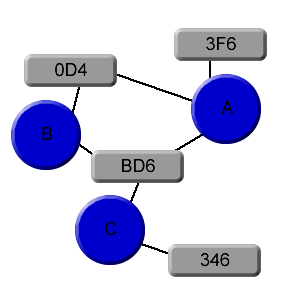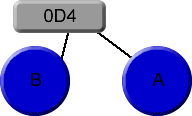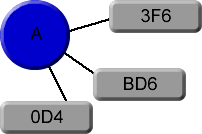Fast path cache generation for a connected node graph
I'm trying to get a faster pathfinding mechanism in place in a game I'm working on for a connected node graph. The nodes are classed into two types, "Networks" and "Routers."

In this picture, the blue circles represent routers and the grey rectangles networks.
Each network keeps a list of which routers it is connected to, and vice-versa. Routers cannot connect directly to other routers, and networks cannot connect directly to other networks.

Networks list which routers they're connected to

Routers do the same
I need to get an algorithm that will map out a path, measured in the number of networks crossed, for each possible source and destination network excluding paths where the source and destination are the same network. I have one right now, however it is unusably slow, taking about two seconds to map the paths, which becomes incredibly noticeable for all connected players.
The current algorithm is a depth-first brute-force search (It was thrown together in about an hour to just get the path caching working) which returns an array of networks in the order they are traversed, which explains why it's so slow. Are there any algorithms that are more efficient?
As a side note, while these example graphs have four networks, the in-practice graphs have 55 networks and about 20 routers in use. Paths which are not possible also can occur, and as well at any time the network/router graph topography can change, requiring the path cache to be rebuilt.
What approach/algorithm would likely provide the best results for this type of a graph?
Dijkstra's shortest path algorithm is the classic, but is only designed for static graphs.
You can try searching the web for dynamic shortest past algorithms.
Here is one paper which seems relevant: http://www.utdallas.edu/~edsha/papers/bin/Globecom04_SPT.pdf (and might give you other leads).
This paper describes a network of routers, where each router maintains it's own Shortest Path Table. Perhaps you can do something similar.
I suggest you also look at routing algorithms in general as taking the shortest path always might cause congestion etc (I am thinking 16 team Halo!). You might also want to incorporate load balancing etc.
Hope it helps.
- Simple basic explanation of a Distributed Hash Table (DHT)
- Way to go from recursion to iteration
- If no functions included in a header file are used, does the compiler still compile this file?
- When should you use a field rather than a property?
- What is referential transparency?
- What algorithm should I implement to program a room cleaning robot?
- How would you access Object properties from within an object method?
- Can you please explain Reed Solomon encoding part's Identity matrix?
- Linear time algorithm for computing radius of membership hyper-sphere
- Reusing a feature to split regression decision tree's nodes
- constructing a non deterministic turing machine
- Purpose of singletons in programming
- How to do I parse a input string in SLR(1) parser with grammar having epsilon?
- ? operator without else-part
- How do I check if a directed graph is acyclic?
- What is the point of interfaces in PHP?
- Intuitive Understanding of GCD algorithm
- What is Turing Complete?
- Recommendation algorithm (and implementation) for finding similar items and users
- Programming Paradigm Beginner
- Proof that the halting problem is NP-hard?
- What is a lambda (function)?
- Difference Between Cohesion and Coupling
- Church Numerals: how to encode zero in lambda calculus?
- How are extremely large numbers handled?
- Should None be considered a data type? (Python)
- Finding a regular expression
- Why is array element referencing a constant time operation?
- How does useState change even when it's a const?
- Are there any O(1/n) algorithms?